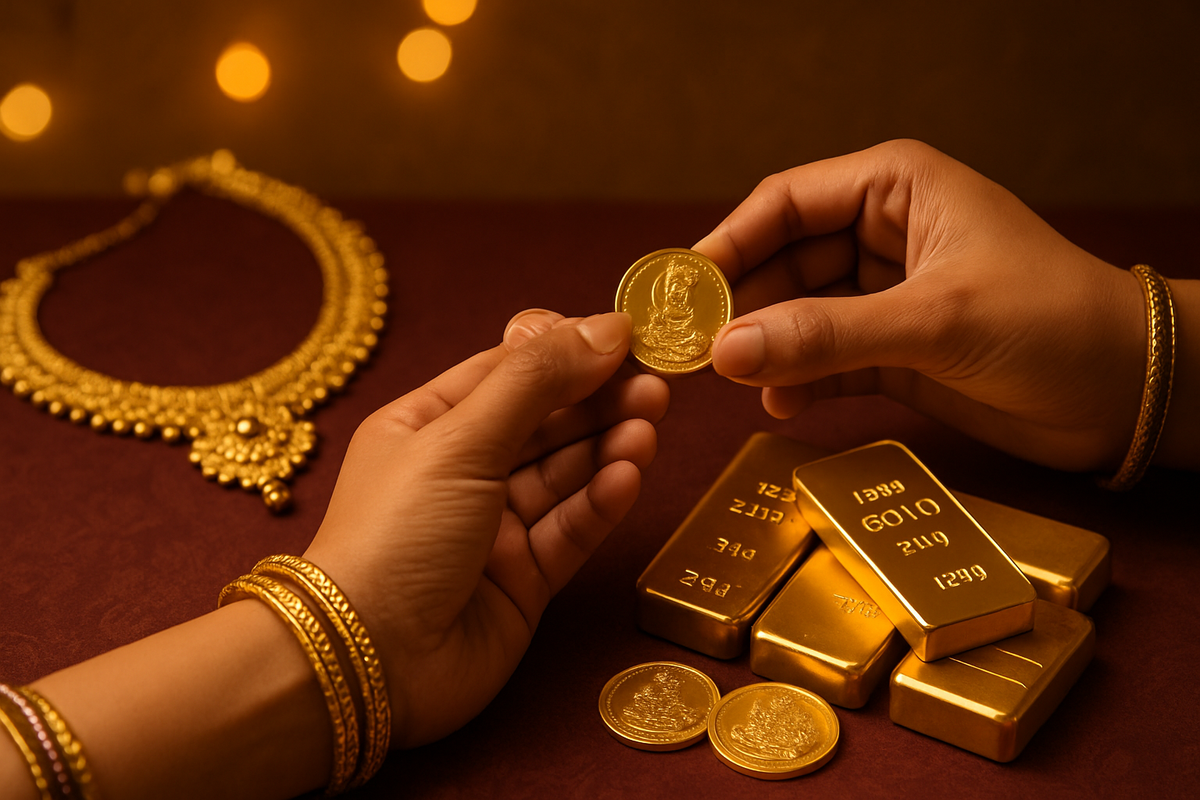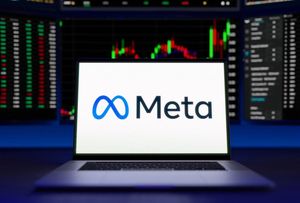
Mumbai, India – October 20, 2025 – India, the world's second-largest gold consumer, is currently navigating an unprecedented era of record-high gold prices. As of October 20, 2025, 24-carat gold has soared to approximately ₹130,860 per 10 grams, a staggering 66% increase year-to-date. This dramatic surge is fundamentally altering traditional consumer demand and festival buying patterns, particularly during the auspicious Diwali and Dhanteras seasons. The most significant shift observed is a pronounced pivot from traditional, elaborate gold jewelry towards investment-oriented gold coins and bars, signaling a profound socio-economic recalibration in how Indians perceive and acquire their most cherished asset.
This transformation is driven by a confluence of global geopolitical tensions, robust investment demand, a weaker U.S. dollar, and expectations of dovish monetary policies from central banks. While the cultural and emotional significance of gold remains deeply ingrained in Indian society, the economic realities of record prices are compelling consumers to adopt more strategic purchasing behaviors. This shift has immediate implications for the vast Indian gold market, influencing everything from retail strategies to the broader financial landscape.
The Shifting Sands of Gold: From Adornment to Asset
The current gold rally in India is not merely a price hike; it's a catalyst for a paradigm shift in consumer behavior. On October 18, 2025 (Dhanteras), 24-carat gold reached approximately ₹134,800 per 10 grams in major Indian cities, a figure that represents an increase of over 60% since last year's Dhanteras. This surge has created a paradoxical market where, despite a 10-15% decline in physical gold sales volume during Dhanteras 2025, the total value of sales sharply increased due to the elevated prices.
The timeline leading to this moment has been a consistent upward trajectory. Gold prices have seen dramatic growth over the past decade, accelerating significantly in recent years. The COVID-19 pandemic in 2020 initially fueled a surge as gold acted as a safe haven. By Dhanteras 2023, gold hit an all-time high of approximately ₹60,579 per 10 grams, with coins and bars already accounting for about 30% of total sales. Dhanteras 2024 saw 24k gold futures on MCX reach around ₹78,804 per 10 grams, a 30% year-on-year gain, with investment demand constituting 75% of total gold demand. Early 2025 witnessed an accelerating surge, driven by escalating global uncertainties, a weakening US dollar, expectations of US Federal Reserve interest rate cuts, and substantial gold purchases by central banks. By October 2025, international prices had surpassed the $4,000 per ounce mark, and domestic prices mirrored this with an average of over ₹95,000 per 10 grams.
Key players in this evolving landscape include millions of Indian consumers, who are now exhibiting "smart and strategic buying," opting for smaller quantities or investment-grade gold. Jewelers, from large organized chains like Titan Company Limited (NSE: TITAN) and Kalyan Jewellers India Limited (NSE: KALYANKJIL) to local artisans, are on the front lines, adapting their business strategies by offering discounts on making charges, promoting lightweight jewelry, and pushing alternative collections. Bullion dealers, on the other hand, are experiencing a boom, with gold coins and bars "flying off the shelves," sometimes quoting premiums of up to US$25 per ounce over official domestic prices. Investment vehicles like physically backed gold and silver Exchange Traded Funds (ETFs) are also seeing strong inflows, particularly from institutional and affluent investors.
The defining characteristic of this shift is the pronounced move away from traditional, elaborate gold jewelry towards simpler forms like gold coins and bars. This is primarily driven by cost-effectiveness; manufacturing charges for jewelry typically add 10-20% to the gold's base price, whereas coins and bars generally incur only a 3% Goods and Services Tax (GST), making them a more attractive option for investment-focused buyers. This fundamental redefinition of luxury and investment is reshaping one of the world's largest gold markets.
Corporate Fortunes in a Golden Crucible
The record gold prices and the subsequent shift in consumer behavior present a mixed bag of fortunes for public companies operating in the Indian gold market. Agility, diversification, and strong operational efficiencies are proving to be key differentiators.
Potential Winners:
- Titan Company Limited (NSE: TITAN): As a dominant organized jewelry retailer with brands like Tanishq, CaratLane, and Mia, Titan is well-positioned. Its diversified portfolio, including traditional gold, studded jewelry, and affordable segments, allows it to cater to evolving tastes. The company has shown resilience, with its jewelry business growing despite high gold prices, particularly in studded jewelry. Titan's proactive introduction of 9-carat gold collections in CaratLane and leveraging investment-grade gold coins demonstrate strategic adaptability. Its strong brand equity and extensive network help manage inventory costs and hedge against volatility.
- Kalyan Jewellers India Limited (NSE: KALYANKJIL): This leading pan-India retailer has reported robust revenue growth, driven by wedding demand and successful penetration into non-South markets through a franchise model. Kalyan's efficient inventory management and ability to capture a significant share of the wedding market position it to benefit from the shift towards organized retail and higher value sales.
- MMTC-PAMP: As India's largest and only LBMA-accredited gold and silver refinery, MMTC-PAMP (a joint venture between public sector MMTC and Switzerland's PAMP SA) directly benefits from the increased demand for investment-grade gold coins and bars. Its focus on refining domestic scrap gold is also crucial, as higher prices encourage more recycling, further cementing its role in the financialization of gold.
Companies with Mixed Impact:
- Rajesh Exports Limited (NSE: RAJESHEXPO): While a global leader in gold refining and jewelry manufacturing, its diverse operations face contrasting impacts. Its large-scale refining operations (e.g., Valcambi) could benefit from increased gold recycling and financialization. However, its traditional jewelry manufacturing and retail segments (Shubh Jewellers) face headwinds from reduced volume demand for heavy gold jewelry, leading to potential sales and margin pressures.
- PC Jeweller Limited (NSE: PCJEWELLER): With numerous showrooms across India, PC Jeweller, like other retailers, will likely see a decline in volume sales of plain gold jewelry. Its ability to diversify into diamonds and silver, coupled with strategic expansion and leveraging gold loan policies, will be crucial for navigating the high-price environment.
- Thangamayil Jewellery Limited (NSE: THANGAMAYL): A regional player in Tamil Nadu, known for affordability and traditional designs, Thangamayil's strong regional presence and hedging policies are strengths. However, its price-sensitive customer base in Tier-2 and Tier-3 cities might be more impacted by record gold prices, potentially affecting volume sales unless it aggressively pushes lighter or alternative products.
Potential Losers:
- Smaller, Unorganized Jewelers: These local, often family-run businesses, heavily reliant on traditional heavy gold jewelry sales, are facing significant challenges. They lack the financial muscle, brand trust, and operational flexibility of larger players to adapt to rapid changes in consumer behavior and pricing. They are likely to lose market share and face severe margin pressures, accelerating the formalization of the jewelry market.
In essence, companies with diversified product portfolios, strong brand presence, efficient hedging strategies, and a focus on customer engagement through exchange schemes are better positioned to succeed. Conversely, those heavily reliant on traditional heavy gold jewelry sales, particularly in the unorganized sector, are likely to face significant revenue and margin pressures.
Wider Ripples: Socio-Economic Shifts and Policy Implications
The unprecedented surge in gold prices and the subsequent shift in consumer behavior have profound wider socio-economic significance for India. The sheer magnitude of the price increase—a 66% rise in less than a year—distinguishes this period from historical precedents.
Socio-Economic Impact:
- Wealth Effect: Indian households collectively hold an estimated 34,600 tonnes of gold, valued at roughly $3.8 trillion. The dramatic appreciation in prices has significantly boosted household wealth, creating a positive wealth effect on balance sheets.
- Investment Over Adornment: The shift towards investment-driven purchases (coins, bars, digital gold) reflects a maturing financial literacy among consumers, who are increasingly viewing gold as a strategic asset for wealth management and a hedge against inflation.
- Gold Loan Market Boom: Gold loan Non-Banking Financial Companies (NBFCs) like Muthoot Finance (NSE: MUTHOOTFIN) and Manappuram Finance (NSE: MANAPPURAM) are experiencing a boom. Higher gold prices increase the loanable value of pledged gold, improving loan-to-value (LTV) ratios and asset quality for lenders. The gold loan market is projected to reach ₹15 trillion by FY26.
- Import and Trade Deficit: Elevated gold imports, driven by strong demand despite high prices, are a significant factor widening India's merchandise trade deficit. In September 2025, the trade deficit surged to $32.15 billion, primarily fueled by gold imports, putting pressure on the Indian rupee and foreign exchange reserves.
Broader Industry Trends:
This domestic phenomenon is part of a broader global gold rally, with international prices surging 58% year-to-date, driven by central bank buying, robust ETF inflows, and geopolitical tensions. India's gold market is also witnessing a growing interest in alternative investments. Gold ETFs have seen unprecedented inflows, with assets under management (AUM) doubling in 2025. Silver has also experienced a significant price surge, outperforming gold in percentage terms, driven by investor interest and strong industrial demand. The rise of digital gold platforms continues to provide accessible investment avenues.
Regulatory and Policy Implications:
- Smuggling Surge: Record-breaking prices and high import duties (despite a reduction to 6% last year) have created lucrative incentives for gold smuggling, which has surged to unprecedented levels. Smugglers can earn margins exceeding ₹1.15 million per kilogram by bypassing duties and local sales tax, overwhelming policy interventions. The government might face pressure to reconsider import duties to manage the current account deficit and curb illicit trade.
- Current Account Deficit Management: The widening trade deficit due to gold imports necessitates a multi-faceted approach from the government, potentially including promoting domestic gold recycling or encouraging non-gold investments to mitigate the pressure on the rupee.
- RBI Regulations: The Reserve Bank of India (RBI) continues to influence the gold loan market, implementing tiered LTV ratios and expanding Gold Metal Loans (GMLs). The RBI has also modestly increased its gold reserves, which now comprise 14% of India's foreign exchange reserves, largely due to valuation gains.
Historical Precedents:
While India has seen gold price fluctuations throughout its history, the current rally of 2025, with prices exceeding ₹130,000 per 10 grams, represents a more dramatic and sustained surge than previous periods. Similar to past spikes, gold continues to act as a safe-haven asset during global uncertainty. However, the current period is distinguished by the sheer magnitude of the price increase, the explicit shift towards investment products, and an unprecedented surge in smuggling profitability.
The Golden Horizon: What Comes Next
The Indian gold market is poised for continued evolution, with both short-term adjustments and long-term transformations on the horizon.
Short-Term Possibilities (Next 12-18 Months):
- Resilient Demand, Evolving Composition: Cultural significance will ensure sustained gold demand, especially for weddings and festivals. However, the volume of physical gold jewelry purchases may continue to decline, even as the monetary value of sales for jewelers remains robust due to higher prices.
- Investment Gold Dominance: Gold coins, bars, and digital gold are expected to maintain strong momentum as preferred investment avenues.
- Rising Demand for Alternatives: Silver and diamonds will continue to see strong demand as consumers seek more affordable yet aspirational alternatives.
- Potential for Price Correction: While the overall sentiment is bullish, some analysts suggest that gold prices might enter overbought territory, making a healthy correction possible in the short term.
Long-Term Possibilities (Beyond 18 Months):
- Accelerated Financialization of Gold: The trend of viewing gold as a strategic investment will intensify, with Gold ETFs, Sovereign Gold Bonds (SGBs), and digital gold becoming primary investment avenues, particularly for younger, urban investors.
- Diversified Precious Metals Market: The Indian market is poised for a more diversified landscape where diamonds and silver establish larger, more permanent niches alongside gold.
- Sustained Price Appreciation: Gold prices are projected to continue their upward trajectory, potentially reaching ₹140,000 to ₹225,000 per 10 grams by 2030, supported by global uncertainties and central bank purchases.
- India as a Hub for Gold Innovation: India is expected to strengthen its position in gold innovation and manufacturing, leveraging its skilled workforce and technological advancements.
Strategic Pivots and Adaptations for Businesses:
Indian gold businesses, particularly jewelers, must embrace several strategic pivots:
- Product Innovation and Diversification: Focus on creating intricate, lightweight, and design-centric jewelry using less gold (e.g., 18K and 14K options). Significantly invest in diamond, silver, and even platinum inventory and enhance design capabilities for these alternative precious metals.
- Enhanced Customer Engagement: Actively market gold coins, bars, and digital gold options. Introduce or expand gold savings schemes, exchange programs for old gold, and flexible payment options.
- Digital Transformation: Strengthen e-commerce platforms, offering a wide array of designs, transparent pricing, and trusted certifications. Leverage data-driven inventory management and optimize supply chains.
Market Opportunities:
The growth of digital gold and ETFs, the surge in demand for silver and diamonds, and the expanding online jewelry market present substantial opportunities for diversification and growth. Gold-backed financial services are also experiencing enhanced market performance.
Market Challenges:
Sustained high prices will continue to strain affordability, leading to a decline in physical gold jewelry volumes. Increased competition from alternative precious metals and price volatility due to global economic shifts remain significant challenges, particularly for smaller jewelers.
The Enduring Allure: A Golden Future
The record gold prices in India are undeniably reshaping an ancient market, pushing consumers and businesses alike to adapt. The key takeaway is a fundamental shift: while gold's cultural and auspicious significance remains undiminished, its role as a pure investment asset is gaining unprecedented prominence. The "Fear of Missing Out" (FOMO) on potential further price rallies is a powerful motivator, driving consumers to buy strategically, often opting for coins and bars over elaborate jewelry.
Moving forward, the Indian gold market will likely be characterized by continued price appreciation, driven by global uncertainties, central bank buying, and a weakening rupee. This bullish outlook, however, presents a dual challenge for the traditional jewelry sector, which will need to innovate and diversify aggressively to maintain relevance. The rise of gold loan companies and gold ETFs signals a maturing financial ecosystem that is effectively leveraging gold's intrinsic value.
For investors, the coming months demand vigilance. Monitoring global and domestic cues, such as international gold prices, the U.S. dollar's strength, and any shifts in Federal Reserve policy, will be crucial. Considering buying on dips, embracing diversification, and exploring investment options beyond physical jewelry, such as gold mutual funds and ETFs, are prudent strategies. While the long-term outlook for gold remains strong as a safe-haven asset, investors should be prepared for potential price volatility. The enduring allure of gold in India is not diminishing; it is simply transforming, adapting to a new economic reality where its financial utility is increasingly in the spotlight.
This content is intended for informational purposes only and is not financial advice





